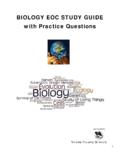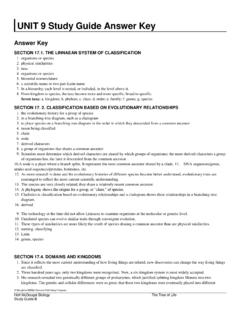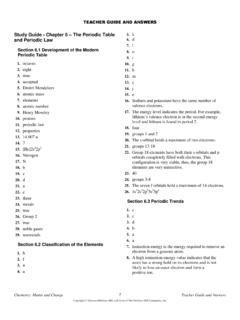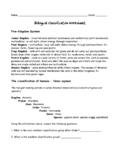Transcription of Study Guide Section 1: The History of Classification
1 Name Date Class In your textbook, read about early systems of Classification . In the space at the left, write the letter of the term or phrase that best completes each statement or answers each question. 1. Which statement describes the Linnaean system of biological Classification ? A. Animals were classified as living either on land, in water, or in air. B. It was a six-kingdom system. C. It was based on behavioral and morphological similarities and differences among organisms. D. Plants were classified by average size and structure. 2. In binomial nomenclature, the first part of an organism s name identifies the genus, and the second part identifies the A. family. B. kingdom. C. phylum. D. species. 3. What is the correct way that the scientific name for the American black bear should appear in print? A. Ursus A.
2 B. Ursus Americanus C. Ursus americanus D. ursus americanus Label the diagram of taxa. Use these choices: class family genus kingdom order phylum species Unit 4 CHAPTER 17 Organizing Life s Diversity 119 Study Guide CHAPTER 17 Section 1: The History of Classification 4. 5. 6. 7. 10. 9. 8. domain Main IdeaDetails PDF PassOrganizing Life s Diversity 171 Name DateEarly Systems of ClassificationI found this informationon page .Taxonomic CategoriesI found this informationon page .Identify the parts of Linnaeus two-word naming system by completing the graphic organizer 1 The History of Classification (continued)Copyright Glencoe/McGraw-Hill, a division of The McGraw-Hill Companies, the genus and specific name, or epithet, for the species name of modern Nomenclature:first word identifies asecond word is called thewhich is awhich often describesspecific epithetgenus1.
3 Compare data in the table below to determine which two animals are most closely related. Support your of Selected Mammals Kingdom Animalia Animalia Animalia Animalia Phylum Chordata Chordata Chordata Chordata Mammalia Mammalia Mammalia Mammalia Class Order Cetacea Carnivora Carnivora Carnivora Family Mysticeti Felidae Canidae Canidae Genus Felis Balenopora Canis Canis Species*B. physalis F. catus C. latrans C. lupus Common name Blue whale Domestic cat Coyote Wolf 2.
4 Analyze at which level the blue whale diverges from the other animals on the table.* The species name is indicated as binominal 1712/27/10 6:53:26 AM2/27/10 6:53:26 AMName Date Class In your textbook, read about determining species. Complete the table by filling in the missing information. Use these choices: biological evolutionary History extinct fertile molecular data physical variations Species Concept Description Disadvantage Advantage Typological Classification is determined by comparison of (1) characteristics with a type specimen. Classification does not allow for genetic (2) , such as color, within a species. Descriptions provide detailed records of physical characteristics of many organisms. (3) Classification is determined by similar characteristics and ability to produce (4) offspring.
5 Some organisms interbreed occasionally. Does not account for (5) species. Working definition applies in most cases. Phylogenetic Classification is determined by (6) . Evolutionary histories are not known for all species. Accounts for extinct species, considers (7) , and solves problems of other species concepts. In your textbook, read about characters. Match the definition or example in Column A with the term in Column B. Column A 8. features of body structure such as type of beak and wings on birds 9. chromosome banding patterns that show the close relationship among chimpanzees, gorillas, and orangutans 10. model that uses comparisons of DNA sequences to estimate how long species have been evolving independently Column B A. biochemical characters B. molecular clock C. morphological characters 120 Organizing Life s Diversity CHAPTER 17 Unit 4 Study Guide CHAPTER 17 Section 2: Modern Classification Study Guide , Section 2: Modern Classification continued In your textbook, read about phylogenetic reconstruction.
6 Refer to the figure below. Respond to each statement. 11. State the name of this kind of diagram. 12. Identify which dinosaur is the most recent common ancestor of the robin and Archaeopteryx. 13. Determine which traits are shared by Archaeopteryx and robins. For each statement below, write true or false. 14. A branch of a cladogram is called a clade. 15. Scientists have discovered and described 4 million species. 16 Darwin and Haeckel used the analogy of a wheel to represent phylogenies. Unit 4 CHAPTER 17 Organizing Life s Diversity 121 Main IdeaDetails PDF PassOrganizing Life s Diversity 175 Name DateCharactersI found this informationon page .Phylogenetic ReconstructionI found this informationon page.
7 Identify and give examples of the two types of characters in the concept :Morphological Characters: Biochemical Characters:Example: Example: Example: Example: Describe cladograms by completing the paragraph. A is a branching diagram that represents the proposed or evolution of a or group. The groups used in cladograms are called . To a cladogram, characters are identified. Then the of various species is identified based on the or of the derived characters in the . In making a cladogram, assume that groups that more derived characters have a more common 2 Modern Classification (continued)Copyright Glencoe/McGraw-Hill, a division of The McGraw-Hill Companies, a process scientists use to construct a cladogram that includes a new species of vascular plant that was recently discovered in the rainforest.
8 1752/27/10 6:53:31 AM2/27/10 6:53:31 AMName Date Class In your textbook, read about domains and kingdoms. Complete the table by filling in the missing information. Use these choices. Animalia Archaea Bacteria Bacteria Eukarya Fungi Plantae Protista Description of Organisms Domain Kingdom(s) Prokaryotes whose cell walls do not contain peptidoglycan 1. 2. Prokaryotes whose cells walls contain peptidoglycan 3. 4. Cells with membrane- bound organelles 5. 6. 7. 8. 9. In the space at the left, write the letter of the term or phrase that best completes each statement. 10. Organisms are classified into domains according to A. cell type. B. cell type and structure. C. cell type, structure, and nutrition. D. nutrition. 11. Which organisms are in the same kingdom because they cannot form organs?
9 A. archaea B. fungi C. plants D. protists 12. Which kingdom s organisms have no cell walls? A. Animalia B. Archaea C. Bacteria D. Plantae Respond to the following statement. 13. Explain why viruses are not included in the biological Classification system. 122 Organizing Life s Diversity CHAPTER 17 Unit 4 Study Guide CHAPTER 17 Section 3: Domains and Kingdoms Name DateCopyright Glencoe/McGraw-Hill, a division of The McGraw-Hill Companies, IdeaDetails PDF Pass178 Organizing Life s DiversitySection 3 Domains and Kingdoms (continued)KingdomCell StructureEnergy SourcesOtherCharacteristicsProtistaFungi PlantaeAnimaliaModel a diagram of the relationship between domains and kingdoms. SUMMARIZED omain EukaryaI found this informationon page.
10 Organize the kingdoms in the Domain Eukar ya and describe their cell structure. List each kingdom s sources of energy and other important 1782/27/10 6:53:35 AM2/27/10 6:53:35 AM









